On View
Painter Gladys Nilsson Got Her Start as a Member of Chicago’s Hairy Who. Now, at 79, She’s Ready to Shine on Her Own
Dual New York shows at Matthew Marks and Garth Greenan explore five decades of her wild, ecstatic paintings.
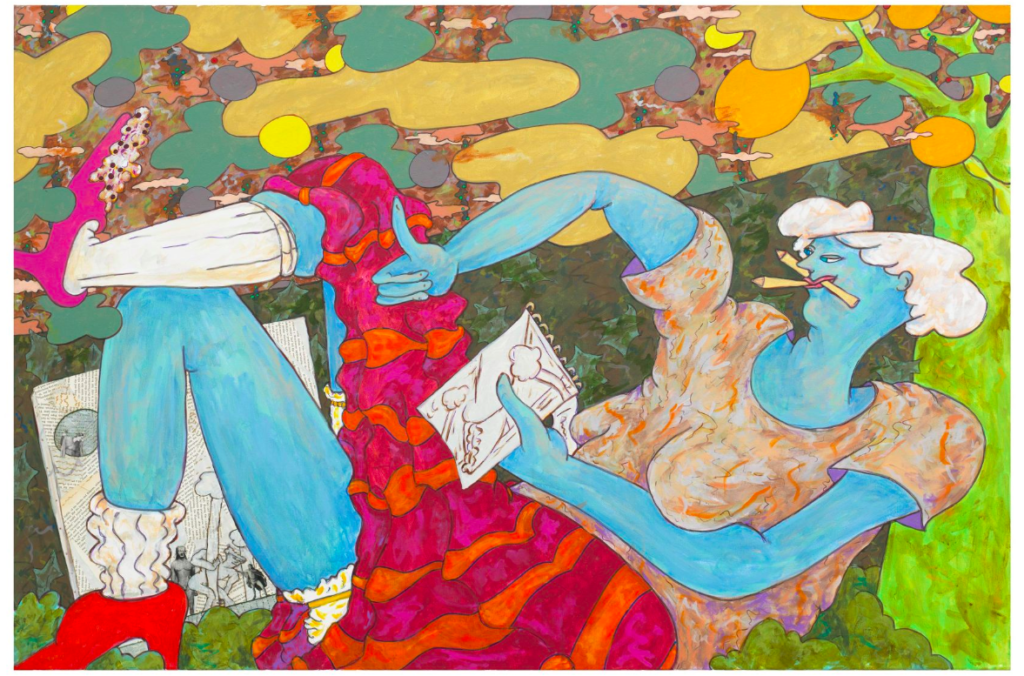
Dual New York shows at Matthew Marks and Garth Greenan explore five decades of her wild, ecstatic paintings.

Caroline Goldstein

Gladys Nilsson was beaming. On a recent afternoon the artist—a member of the Chicago group the Hairy Who, a once-fringe movement that’s increasingly beloved—was strolling through the galleries at Matthew Marks and Garth Greenan, admiring the precise curatorial choices in a much-anticipated fifty-year survey of her work.
“It’s kind of thrilling really, to see them all in the same place” she told Artnet News, strolling through the dual exhibition, which also includes lesser-known aspects of her practice, like collages and early watercolors. Nilsson herself hasn’t seen many of the works in years, since they’ve been sold off to collectors or, in some cases, been languishing in storage.
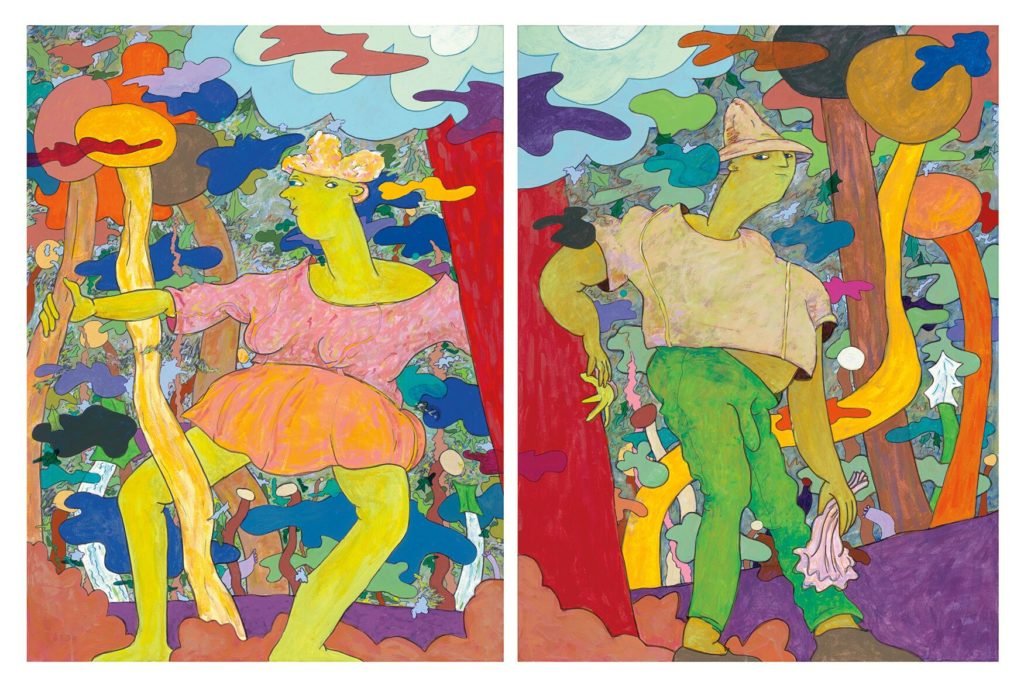
Gladys Nilsson, A Red Tree (2018). Courtesy of the artist, Garth Greenan Gallery, and Matthew Marks Gallery.
The Hairy Who collective formed after its members graduated from the Art Institute of Chicago—where Nilsson is now a professor—and included Jim Nutt (Nilsson’s husband), Jim Falconer, Art Green, Suellen Rocca, and Karl Wirsum. It formed out of necessity, when the artists realized there were few places to show their raucous work. With the help of Don Baum, the exhibitions director at the Hyde Park Art Center, the six recent graduates mounted just a handful of shows over a period of four years, but their success was immediate and has proven lasting.

The Hairy Who in Hyde Park, Chicago. Still from YouTube, courtesy of the Art Institute of Chicago.
What distinguished the Hairy Who was their non-conformist, non-hierarchical approach to art making, which Nilsson credits to the tutelage of Whitney Halstead, an art historian who encouraged his students to look beyond so-called fine art—trawling corner shops, newspapers and magazines, music, film, and comics for offbeat inspiration.
The similarities in approach did not yield a cohesive visual language though. “The only way our work looks related,” Jim Nutt told Jonathan Griffin in 2018, “is if you compare it to the standard of an all-black painting by Ad Reinhardt.”

Installation view of “Gladys Nilsson: Honk! Fifty Years of Painting” at Matthew Marks Gallery. Courtesy of the artist, Garth Greenan Gallery, and Matthew Marks Gallery.
The joint exhibition, titled “Gladys Nilsson: Honk! Fifty Years of Painting,” is organized chronologically: at Matthew Marks, more than 40 works created between 1963 and 1980 are on display, while down the street at Garth Greenan the paintings are the artist’s most recent, dated between 2017 and 2019.
In the first room at Matthew Marks, super colorful, smaller scale works from 1964–1966 invite closer viewing. Nilsson described herself as being in a “holding pattern” during the early years after graduation, but it’s clear that once she found her stride there was no turning back.
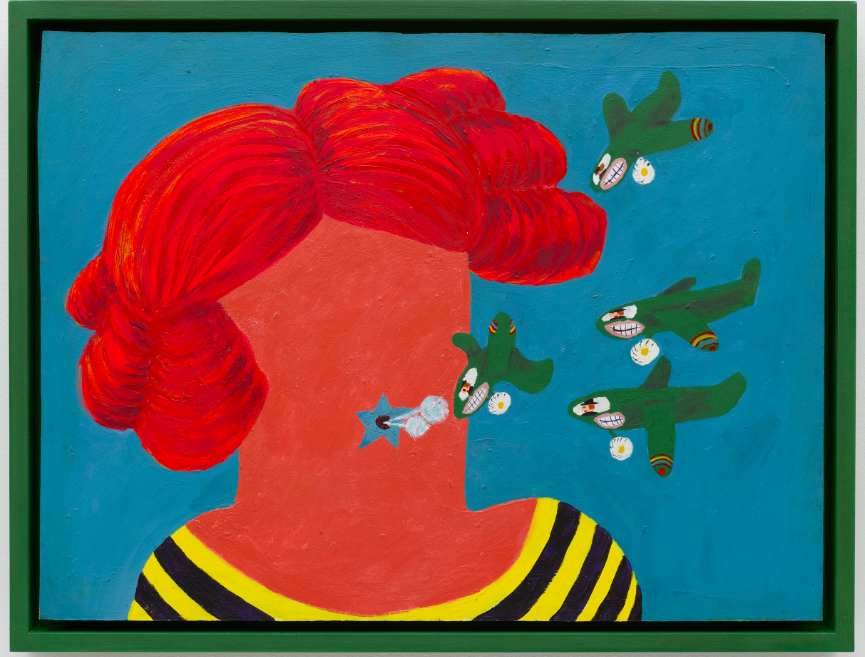
Gladys Nilsson, Gigantica und der Messerschmitts (1965).Courtesy of the artist, Garth Greenan Gallery, and Matthew Marks Gallery.
“I’m always fond of having other people think about what they’d like to read into it,” she says of her paintings. “I’ve always felt the viewer has to work for it, too.” In the work Gigantica und der Messerschmitts (1965) a giant, faceless figure with a swathe of fire-engine red hair is assaulted by tiny green planes; a star-shaped puncture where her mouth should be sends out two whiffs of air, like a balloon deflating.
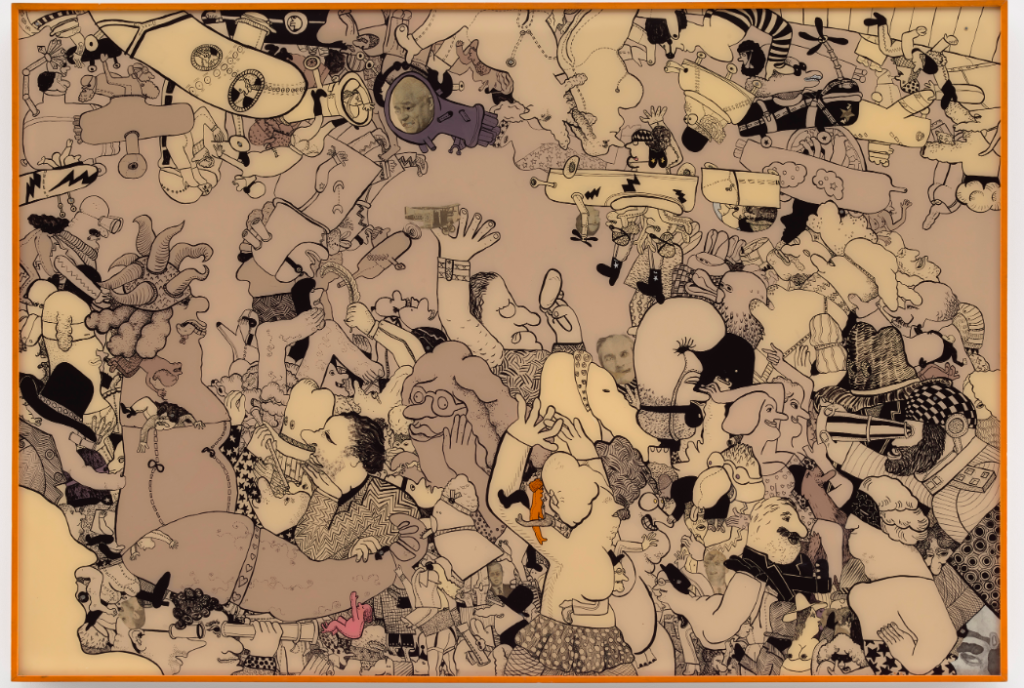
Gladys Nilsson, Very Worldly (1967). Courtesy of the artist, Garth Greenan Gallery, and Matthew Marks Gallery.
While at school, she and Jim Nutt developed a fondness for German Expressionist films, which Nilsson said probably planted the idea of the German aircrafts in her mind. Similar planes resurface in later works, including her forays into paint on Plexiglas, a medium she adopted after watching Nutt play around with it.
Nilsson was drawn to the experimental nature of the process, which involves painting on a reverse film, and only seeing the final composition at the very end. “Building up [the illustrations] you just kind of keep going, adding more” she said, “and then when it’s finished you turn it around and: surprise!”
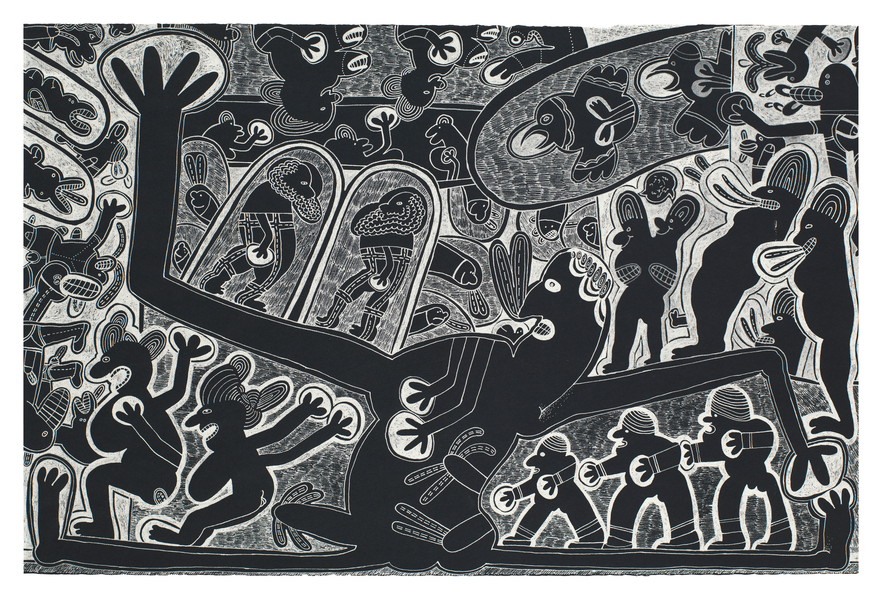
Gladys Nilsson, Untitled (Reach) (1969). Courtesy of the artist, Garth Greenan Gallery, and Matthew Marks Gallery.
In some of her Plexiglas works and in earlier watercolors, Nilsson began incorporating cut-outs from magazines, posters, and even art history books, in a nod to Halstead’s mandate to pay attention to both high and low-brow visual culture. At one point the artist began working on round canvases encased in needlepoint hoops, which appealed to her because “the boundaries are already set for you.”
A series of works from the late sixties and early seventies reveal Nilsson’s deep appreciation for Aboriginal art, borrowing that form’s constellations of tiny dots and silhouetted animals organized in frieze-like procession.
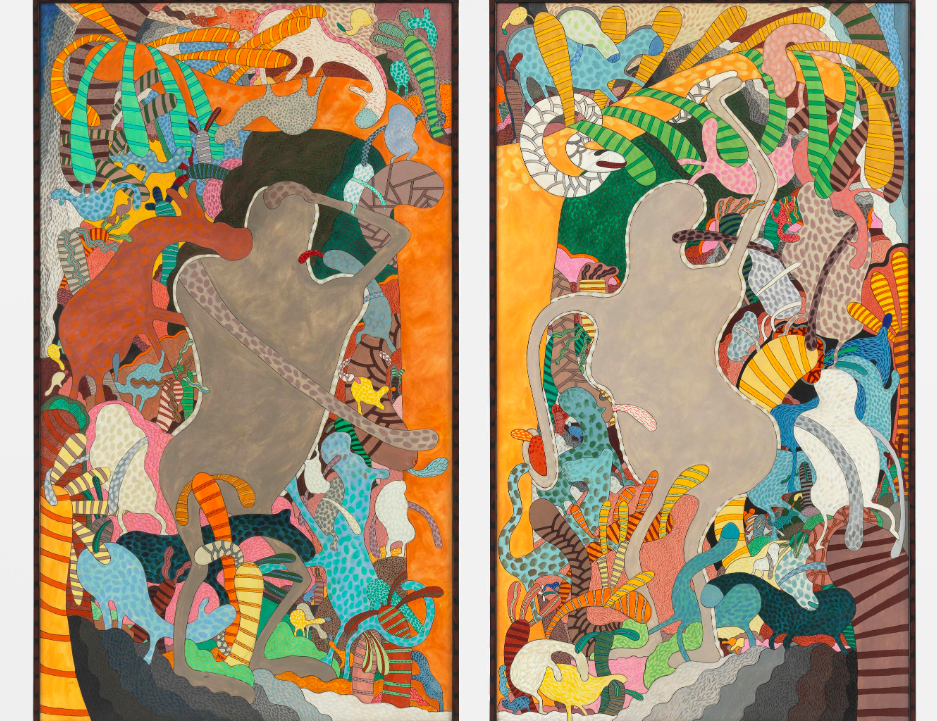
Gladys Nilsson, Dipped Dick: Adam and Eve After Cranach (1971). Courtesy of the artist, Garth Greenan Gallery, and Matthew Marks Gallery.
One of the highlights of the show is Dipped Dick: Adam and Eve After Cranach, in which she recasts the classic 16th-century painting of original sin with Gumby-like figures, set against a rollicking landscape of color and pattern. (A wily, green-striped serpent tangled over a branch extending between the diptych’s two panels.) The painting’s title is a testament to Nilsson’s affection for word play and the occasional dirty joke.
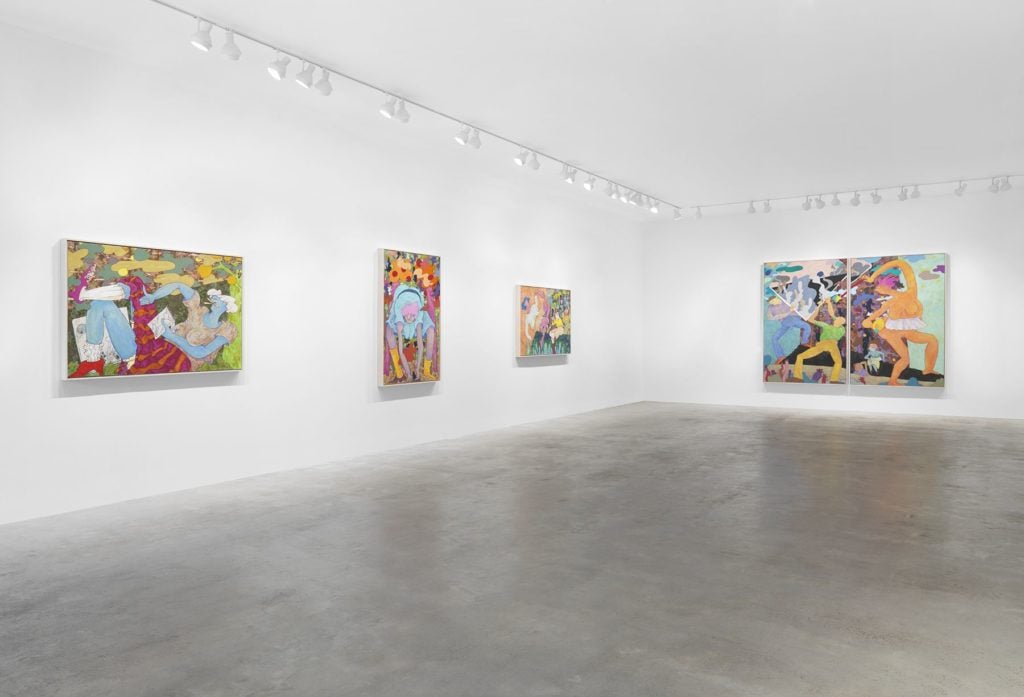
Installation view of “Gladys Nilsson: Honk! Fifty Years of Painting” at Garth Greenan Gallery. Courtesy of the artist, Garth Greenan Gallery, and Matthew Marks Gallery.
The large figures in Dipped Dick set the tone for the most recent works, on view at Garth Greenan. The biggest painting, finished by Nilsson just months ago, measures about seven by nine feet—that’s the maximum size canvas that the artist could fit up the stairs and into her second-floor studio in Wilmette, outside of Chicago. “It’s hard, it’s very physical,” the artist confirms. To reach the top of that canvas, she had to paint from a ladder. She breezily mentioned that she had quite a scare, nearly falling off recently. It’s all in a day’s work; even at the age of 79, she remains unfazed.
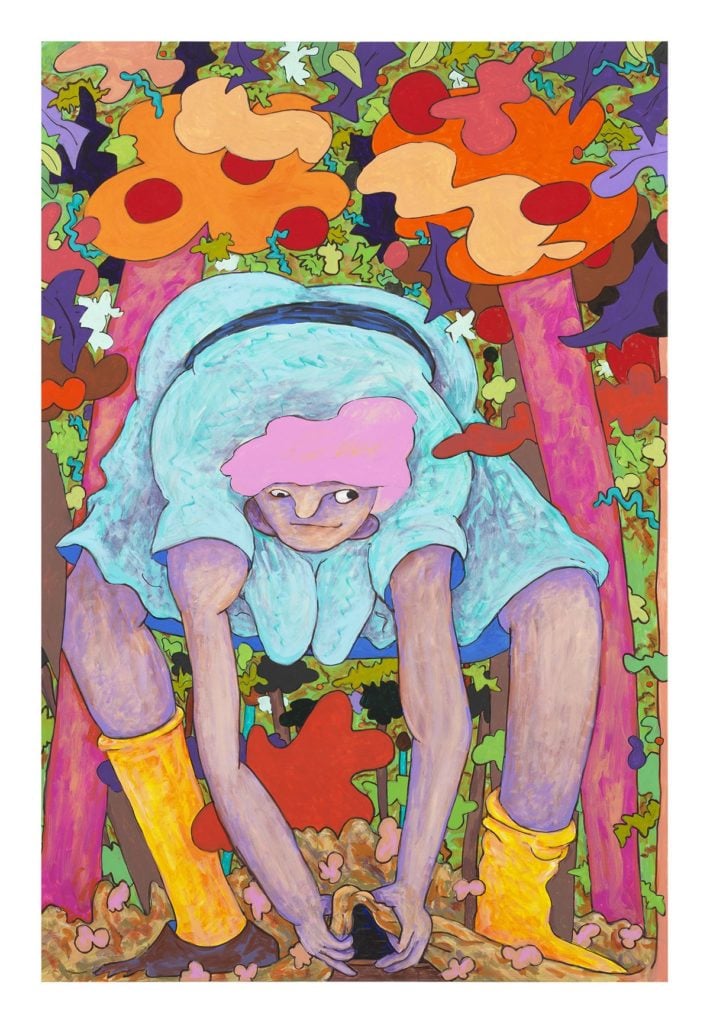
Gladys Nilsson, Tidy Up (2018). Courtesy of the artist, Garth Greenan Gallery, and Matthew Marks Gallery.
The figures who populate Nilsson’s paintings from the last two years are almost indistinguishable at times: large-nosed, thick-trunked, with long, lumpy limbs. The women tend to have bosoms that bounce and flop. Their physical bodies are squeezed and pinched to fit inside the compositions, and every inch of the surface is filled with lively color. It’s not an overstatement to say that these impressive, outsized personalities match the artist’s own spirit. “If you stretched her out,” Nilsson told me, describing one of her blue-skinned giantesses, “she’d be too big for the frame.”
“Gladys Nilsson: Honk! Fifty Years of Painting” is on view at Matthew Marks Gallery, 523 W 24 Street, through April 18, 2020; and at Garth Greenan Gallery, 545 West 20th Street, through March 14, 2020.